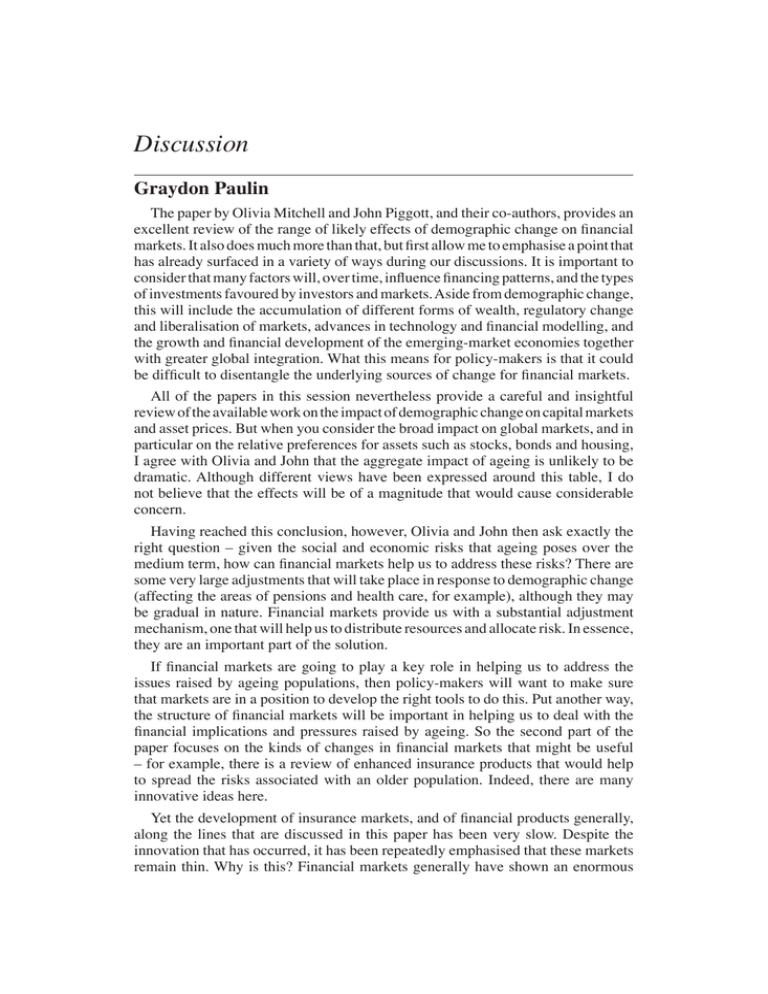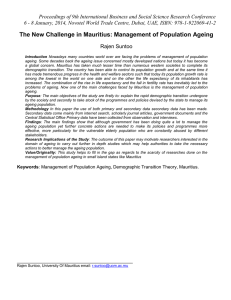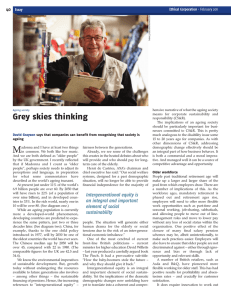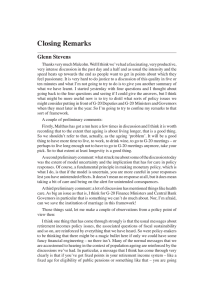Discussion Graydon Paulin
advertisement

Discussion 337 Discussion Graydon Paulin The paper by Olivia Mitchell and John Piggott, and their co-authors, provides an excellent review of the range of likely effects of demographic change on financial markets. It also does much more than that, but first allow me to emphasise a point that has already surfaced in a variety of ways during our discussions. It is important to consider that many factors will, over time, influence financing patterns, and the types of investments favoured by investors and markets. Aside from demographic change, this will include the accumulation of different forms of wealth, regulatory change and liberalisation of markets, advances in technology and financial modelling, and the growth and financial development of the emerging-market economies together with greater global integration. What this means for policy-makers is that it could be difficult to disentangle the underlying sources of change for financial markets. All of the papers in this session nevertheless provide a careful and insightful review of the available work on the impact of demographic change on capital markets and asset prices. But when you consider the broad impact on global markets, and in particular on the relative preferences for assets such as stocks, bonds and housing, I agree with Olivia and John that the aggregate impact of ageing is unlikely to be dramatic. Although different views have been expressed around this table, I do not believe that the effects will be of a magnitude that would cause considerable concern. Having reached this conclusion, however, Olivia and John then ask exactly the right question – given the social and economic risks that ageing poses over the medium term, how can financial markets help us to address these risks? There are some very large adjustments that will take place in response to demographic change (affecting the areas of pensions and health care, for example), although they may be gradual in nature. Financial markets provide us with a substantial adjustment mechanism, one that will help us to distribute resources and allocate risk. In essence, they are an important part of the solution. If financial markets are going to play a key role in helping us to address the issues raised by ageing populations, then policy-makers will want to make sure that markets are in a position to develop the right tools to do this. Put another way, the structure of financial markets will be important in helping us to deal with the financial implications and pressures raised by ageing. So the second part of the paper focuses on the kinds of changes in financial markets that might be useful – for example, there is a review of enhanced insurance products that would help to spread the risks associated with an older population. Indeed, there are many innovative ideas here. Yet the development of insurance markets, and of financial products generally, along the lines that are discussed in this paper has been very slow. Despite the innovation that has occurred, it has been repeatedly emphasised that these markets remain thin. Why is this? Financial markets generally have shown an enormous 338 Discussion ability to innovate rapidly and introduce new products, sometimes of substantial, even worrisome, complexity. So why do they appear slow to expand in this area? There are some possible explanations for the apparently slow development of these particular markets. For example, it could involve the effects of adverse selection, or markets may be in a ‘transition phase’ as they take time to understand these ageing-related risks and adjust accordingly. Constraints may also arise from regulatory and tax regimes, as well as from the limitations of the relevant risk modelling such that large uncertainties remain. We may also need to broaden our definition of what constitutes an annuity, that is, it could partly be a measurement issue. But this is an area that warrants further investigation. We should be cautious when markets appear to be leaving profitable opportunities ‘on the table’ – perhaps they know something that we do not. So is there a role for governments here (and perhaps international organisations, as suggested in the paper)? Eliminating outdated regulatory or taxation provisions that hinder financial development would be a good place to start. Governments may also want to consider encouraging specific markets to develop.1 Further research on risk modelling would be very helpful – this work could come from a number of sources, including academia, and would benefit from improved access to data. Ultimately, governments may wish to absorb additional risk themselves, given their ability to spread that risk across the population. But here it is extremely important to ensure that appropriate criteria for government involvement are identified, so that harmful incentives are not created. Another option, not mentioned in this paper, is the use of public-private partnerships (PPPs) with respect to public infrastructure projects. Governments, in Canada and elsewhere, need to upgrade ageing public infrastructure. At the same time, infrastructure investment is gaining increased acceptance among institutional investors – these projects have a relatively stable long-term cash flow and provide portfolio diversification. So PPPs in this area may provide an attractive longer-term investment for insurers and pension funds. Finally, I would like to add an important caveat to much of what I have said above, and this involves the implications for financial stability. As financial structures change, we will want to assess elements such as the possible excessive concentration of risk. In particular, we do not want the changes that we might encourage to introduce new vulnerabilities into the financial system. The G10 report on ageing and pensions, published in September of last year, noted some of the possible financial stability concerns (G10 2005). An enhanced degree of stress testing, providing an assessment of the impact on the financial, corporate and household sectors from changes in asset prices, would be useful in this regard. Stress testing by financial institutions (including that by central banks with respect to various economic sectors) is becoming an increasingly common practice, involving a steadily rising level of sophistication. It can quickly 1. As an example, the Bank of Canada encouraged the further development of an active Canadian money market in the 1950s and 1960s, although today the environment is rather different. Discussion 339 become complex, particularly when new financial instruments are involved, but, at least at a high level, financial stress analysis could be central to minimising unintended effects. Reference G10 (2005), ‘Ageing and Pension System Reform: Implications for Financial Markets and Economic Policies’, a report prepared at the request of the Deputies of the Group of Ten by an experts group chaired by Ignazio Visco, Central Manager for International Affairs at the Banca d’Italia.











